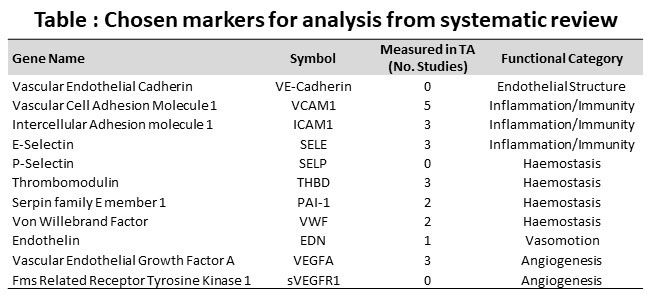Session Information
Date: Monday, November 14, 2022
Title: Abstracts: Vasculitis – Non-ANCA-Associated and Related Disorders II
Session Type: Abstract Session
Session Time: 3:00PM-4:30PM
Background/Purpose: The accurate assessment of disease activity and progression is a major challenge in Takayasu Arteritis (TA). An improved understanding of disease pathogenesis is required to develop novel clinical decision-making tools. We hypothesised that endothelial dysfunction is central to TA disease progression. To evaluate this, we carried out a systematic review on circulating vascular dysfunction (VD) markers in TA and then investigated the association between chosen markers and disease activity in our well-characterised cohort. Lastly, we explored the phenotype of blood derived endothelial cells (EC) from active TA patients.
Methods: For the systematic review, a list of VD markers were defined by text mining and a series of literature searches were made to identify studies where each marker was evaluated in TA. Based on the review, 12 markers were chosen (Table) and measured by ELISA in the plasma of 135 TA patients and 52 age and sex matched healthy control (HC) subjects. TA patients were classified as active (n=42), grumbling (n=22) or stable (n=71) using the Indian Takayasu clinical Activity Score along with radiological features and acute phase reactants (incl. PTX3). Blood derived EC were generated from PBMC of 6 patients with active TA and 5 HC. EC phenotype was interrogated by cytokine activation assays and bulk RNA-seq analysis.
Plasma markers were analysed using non-parametric statistical methods. In dose response experiments, non-linear regression analysis was applied. RNA-seq data was analysed for differential expression with p < 0.05 considered significant.
Results: 18 of the 44 (41%) VD markers identified had been previously measured in TA and 13 (29%) were found to have significantly altered levels.
Plasma levels of E-selectin, P-selectin and PAI-1 were elevated in active TA patients in comparison to HC (+2.3 [1.5-4.2] fold, p< 0.0001; +1.2 [0.9-1.8] fold, p=0.026; +1.5 [1.1-1.9] fold, p< 0.0001; +2.3 [1.1-4.6], p=0.004 respectively, Fig 1A). Furthermore, P-selectin levels correlated with ITAS and PTX3 (rho= 0.19, p=0.033; rho=0.4, p< 0.0001 respectively). Levels of other VD markers were not increased in active TA.
ECFCs derived from patients with active TA demonstrated significantly higher sensitivity to TNFα-mediated induction of VCAM1 and E-selectin mRNA in comparison to HC (p=0.0009 and p=0.0464 respectively, Fig 1B). Consistent with this pro-inflammatory phenotype, RNA-seq analysis of TA ECFC revealed increased expression of inflammation and immunoregulatory genes including E-selectin, ZNF580, MICA, ARIH2 and IL7R.
Conclusion: Herein, we describe a pattern of endothelial dysfunction in active TA which includes increased plasma levels of soluble cell adhesion molecules E-selectin and P-selectin and the pleiotropic fibrinolytic regulator PAI-1. In particular, P-selectin levels may represent a useful, novel disease activity marker. Plasma findings were consistent with the pro-inflammatory phenotype observed in ECFCs derived from patients with active TA. Future work will aim to understand how this molecular pattern of endothelial dysfunction contributes to TA disease progression.
To cite this abstract in AMA style:
Peverelli M, Porter A, Malone K, Kiprianos A, McKinnon T, Pericleous C, Maughan R, Mason J. Active Takayasu Arteritis Is Associated with Plasma and Cellular Measures of Endothelial Dysfunction [abstract]. Arthritis Rheumatol. 2022; 74 (suppl 9). https://acrabstracts.org/abstract/active-takayasu-arteritis-is-associated-with-plasma-and-cellular-measures-of-endothelial-dysfunction/. Accessed .« Back to ACR Convergence 2022
ACR Meeting Abstracts - https://acrabstracts.org/abstract/active-takayasu-arteritis-is-associated-with-plasma-and-cellular-measures-of-endothelial-dysfunction/


